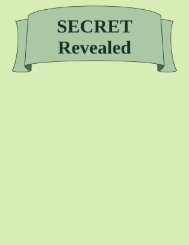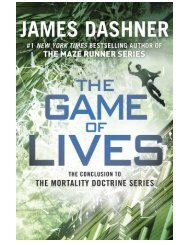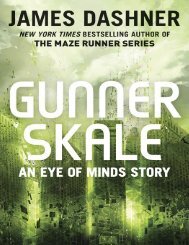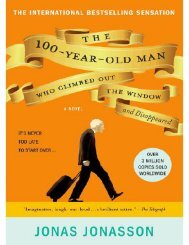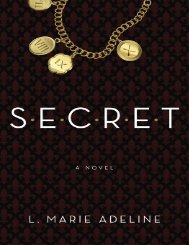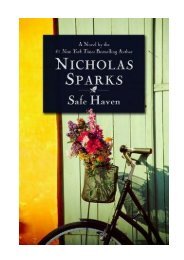32896589326509350
Create successful ePaper yourself
Turn your PDF publications into a flip-book with our unique Google optimized e-Paper software.
week—a long, hot journey to see a gastrointestinal specialist on Long Island and a nasty<br />
fall backwards on the way. She arrived back many hours later, shocked, dehydrated, in a<br />
state of near collapse. She was put to bed and fell into a deep sleep. She awoke the next<br />
morning to the terrifying visions of people bursting through the walls of her room,<br />
which lasted for thirty-six hours. Then she started to feel somewhat better and recovered<br />
her insight into what was happening. At that point, she instructed a young volunteer to<br />
track down an account of Charles Bonnet syndrome on the internet and to give copies of<br />
this to the nursing home staff, so that they would know what had been going on.<br />
Over the next few days, her visions grew much fainter and ceased altogether when she<br />
was talking with others or listening to music. Her hallucinations had become “shyer,”<br />
she said, and now occurred only in the evening, if she sat quietly. I thought of the<br />
passage in Remembrance of Things Past where Proust speaks of the church bells of<br />
Combray, how their sound seemed muted in the daytime, only to be heard when the<br />
hubbub and blare of the day had died down.<br />
C<br />
harles Bonnet syndrome was considered rare before 1990—there were only a handful<br />
of case histories in the medical literature. 2 I thought this strange, for working in oldage<br />
homes and nursing homes for over thirty years, I had seen a number of blind or<br />
purblind patients with complex visual hallucinations of the Charles Bonnet type (just as<br />
I had seen a number of deaf or nearly deaf patients with auditory—and most often<br />
musical—hallucinations). I wondered whether CBS was actually much commoner than<br />
the literature seemed to indicate. Recent studies have conrmed that this is the case,<br />
although CBS is still little recognized, even by doctors, and there is much to suggest that<br />
many or most cases are overlooked or misdiagnosed. Robert Teunisse and his colleagues,<br />
studying a population of nearly six hundred elderly patients with visual problems in<br />
Holland, found that almost 15 percent of them had complex hallucinations—of people,<br />
animals, or scenes—and as many as 80 percent had simple hallucinations—shapes and<br />
colors, sometimes patterns, but not formed images or scenes.<br />
Most cases of CBS probably remain at this elementary level of simple patterns or<br />
colors. Patients who have simple (and perhaps transient or occasional) hallucinations of<br />
this type may not take much notice or remember to report them when they visit a<br />
doctor. But some people’s geometrical hallucinations are more persistent. One old lady<br />
with macular degeneration, learning of my interest in such matters, described how in<br />
the first two years of her visual impairment, she saw<br />
a big blob of light circling around and then vanishing, followed by a colored ag in<br />
sharp focus … it looked exactly like the British ag. Where it came from, I do not<br />
know.… For the last few months I have been seeing hexagons, often hexagons in<br />
pink. At rst there were also tangled lines inside the hexagons, and other little balls<br />
of color, yellow, pink, lavender, and blue. Now there are only black hexagons<br />
looking for all the world like bathroom tiles. 3




